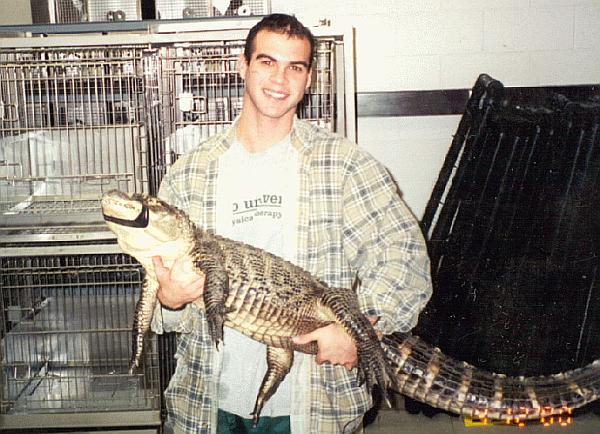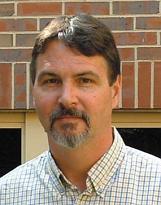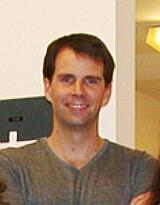Division of Vertebrate Morphology (DVM): 2003 Spring Newsletter
In this newsletter:
- Message from the Chair
- Message from the Program Officer
- Message from the Secretary
- Elections: Candidates for DVM Program Officer
Message from the Chair
Frank FishNow that many of us are starting to come out of our winter hibernation or at least thaw out, we look forward to an even more productive year of research. This past SICB meeting in Toronto showed itself to be a wonderful venue for the display of our collective research efforts. I would like to thank everyone who came to Toronto. Traveling away from home at this time of year is always fraught with a certain amount of risk, usually from the weather and airline schedules. However more recently, travel particularly across international boundaries has become more arduous. I appreciate those people, who made poster presentations, and who had to pass through airport security carrying mailing-tubes that resembled weapon launchers. Typically, DVM had a large number of contributed presentations and posters. Our biggest problem with so many presentations was that Morphology had competing sections through most of the meeting. In my view, this is not a problem, but rather a minor inconvenience. A major inconvenience was the scheduling of the poster presentations at mid-day. This trial had about a much support as a Raelian cloning proposal submitted to NSF. Next year, the posters sessions will be scheduled for late afternoons. One of the more fun things attempted at this meeting was to have "Video Night" at the DVM social. Some incredible videos were shown. Tobias Landberg presented "Beneath the Surface", a time-lapse video of the decomposition preparation of a monkey skeleton (only morphologists could see the art in this!). Beth Brainerd and Tom Hoogendyk had "An Exposition of Vertebrate Yawning". In addition, Natalia Rybczynski present out-takes from a video on beaver and Richard Essner showed video of flying squirrels. I believe the quality of the video and the reaction from the audience was sufficient to hold this event again at the next meeting in New Orleans.
One of the really exciting events sponsored by DVM has been the establishment of regional meetings. These meetings are less formal than the annual SICB meeting. They allow students greater participation with less stress, provide a place to present new ideas, and give researchers the opportunity to make regional collaborations. Brigitte Demes has offered to host the next Northeast Regional DVM meeting at the State University of New York at Stony Brook. The meeting will be held on Saturday, October 4th. The meeting will have mostly short, 5-minute contributions. This is enough time to present a few slides with one really good idea or 20 slides with one really fast talker. Having tried this format for the first time last year, I found it to be a marvelous alternative to standard meeting presentations. I strongly encourage people in the Northeast or elsewhere to come to this meeting. For that matter, I would urge each region to try and organize regional meetings. The meetings could be given annually of biennially. Indeed, funds are available through the DVM and SICB to support such endeavors.
Lastly, it should be noted that the strength of our division is not merely a reflection of the high quality of research that we perform, but it is also a reflection of the excellence of the people who perform the administrative duties of the DVM. Beth Brainerd was elected as the DVM Chair-Elect. Beth has been a friend and collaborator, and we will work to maintain the strength of the DVM. I am especially appreciative of the efforts of the nominating committee of John Hermanson (chair), Anna Ahn, and Kiisa Nishikawa. The nominating committee came up with three distinguished candidates, John Bertram and Duncan Irschick for DVM Program officer and Audrone Biknevicius to continue as DVM Secretary. In addition, the D. Dwight Davis Award Committee of Jeff Walker (chair), Matt McHenry, Rick Blob, and Miriam Ashley-Ross are gratefully acknowledged for their hard work in choosing Gregor Yanega for the Davis Award and Jeffrey Willey for the Student Poster Award. Finally, Kathleen Smith, who was DVM Chair until this past January, is applauded for her work for the division.
I hope that the rest of the year is enjoyable and productive and I hope to see you all in New Orleans.
Message from the Program Officer
Bret TobalskeThe Toronto meeting was vigorous and featured many interesting presentations including a fascinating Bartholomew Award Lecture by one of our own division members: Adam Summers. Congratulations, and nice work, Adam!
While many aspects of the meeting were successful, judging from member feedback, it is clear that scheduling the poster sessions from 11:20 - 1:20 was a failure. The switch from the traditional evening sessions to lunchtime sessions was an attempt on the part of the program officers (including me -it seemed like a good idea at the time-) to improve attendance and highlight the posters. Alas, the schedule change had the opposite effect. As program officers, we felt that the traditional evening sessions were under attended because many people (rightfully) enjoy socializing over dinner at local restaurants and do not manage to wander back to the hotel for the posters. Here is the new plan: for the 2004 meeting in New Orleans, will have poster sessions from 3 to 5 the first two days, 2 to 5 the third day, and no poster session on the last day. There will be no contributed papers or symposiums during these times. This schedule should foster rewarding poster sessions for all concerned.
Please send me any suggestions you may have to improve events related to contributed paper sessions. Note that all program officers gather in late September to organize the annual meeting. At that time, we select rooms for each division and assign papers to specific sessions. The keywords you select on your abstract submission play a critical role during session assignment. Last fall, I gathered contributed papers by themes, and this resulted in some sessions featuring research on vertebrates, invertebrates, and plants. It is my hope that the thematic grouping fosters interaction among members of different divisions.
Regarding symposia, at the 2004 New Orleans meeting, DVM is co-sponsoring John Swallow's symposium on the use of selection experiments as a tool in physiology research. This theme should be of interest to many of us who are interested in functional morphology. Looking further ahead, I have received an appealing proposal for a symposium at the 2005 San Diego meeting from Doug Altshuler. His symposium theme is morphological and physiological adaptation to life at high elevation.
Additionally, Patricia Morse is organizing upcoming symposia for 2005 and 2006 with the general theme of "Biology As a Way of Knowing." The 2005 symposium in this series will explore Biomechanics, and, in 2006, the specific theme will be Evolutionary and Developmental Biology. One goal for these symposia is to develop teaching materials including textbooks suitable for undergraduate, integrated lecture and lab courses. You may contact Patricia if you are interested in participating in these symposia or would like to nominate speakers.
I encourage graduate students in our division to apply for a Grant-in-Aid of Research through the society. The application form is available on the web site, and the next due date will be in November.
Good luck with your research this spring.
Message from the Secretary
Audrone Biknevicius1. Please join me in congratulating the 2003 DVM student award winners. The winning oral presentation for the DVM D. Dwight Davis Award was Gregor Yanega (University of Connecticut) for "The hummingbird bill as a utensil for insectivory: prey-capture and transport in the ruby-throated hummingbird." The winning poster for the DVM Best Student Poster Award was Jeffrey Willey (Clemson University; see photo below) for "Tail function during aquatic walking in snapping turtles."

2. The DVM homepage typically contains reports from the DVM officers, special notices from the membership, and, when appropriate, election news (biographies of candidates, election results). Please keep in mind that this is also an appropriate venue for announcing upcoming events of interest to DVMers, such as regional meetings. Both text and images are accepted. Submissions should be sent to me. Deadlines for submissions for the fall newsletter is September 30th (for a November 8th posting online). In addition, please note that the bottom of the DVM homepage now has a link to the job-posting page. Departments wishing to post job opportunities on the SICB website should submit advertisements directly to the SICB webmaster (Dr. Ruediger Birenheide, webmaster@sicb.org ).
3. BE SURE TO REVIEW THE CANDIDATES FOR THE DVM PROGRAM OFFICER AT THE END OF THIS NEWSLETTER.
ANNOUNCEMENT: 2003 Northeast Regional DVM meetings
The 2003 Northeast Regional DVM meetings will be hosted by the Department of Anatomical Sciences at the State University of New York at Stony Brook on Saturday, October 4th. We will adopt last year's successful format, having a one-day meeting and mostly short contributions (5 minutes). More information will be distributed in the summer (primary contact Brigitte Demes; phone 631/444-3119; e-mail Brigitte.Demes@sunysb.edu). Please mark your calenders and keep this date open. We are looking forward to see you in Stony Brook this fall! (submitted by Brigitte Demes, Susan Larson, Callum Ross and other friendly functional morphologists and biomechanists at Stony Brook)
ANNOUNCEMENT: American Naturalist
Jonathan Losos is the new editor in chief of the American Naturalist and has announced an expansion in the fields of research that the journal would like to publish. This expansion explicitly includes organismal functional morphology and biomechanics that addresses ecological and evolutionary questions. Further, even papers that are more focused on functional issues that would be of interest in ecology or evolution are now welcomed by the American Naturalist. If your work has an ecological or evolutionary slant or focus, please consider the American Naturalist as an outlet for an upcoming paper. If you have questions about whether your work may be appropriate please feel free to contact Peter Wainwright or Jonathan Losos. (submitted by Peter Wainwright, the Associate Editor for the American Naturalist).
ANNOUNCEMENT: 7th International Congress of Vertebrate Morphology
The 7th International Congress of Vertebrate Morphology will held on 27 July - 1 August 2003 at Florida Atlantic University, Boca Raton, Florida, USA. Abstracts for contributed poster and oral presentations will be due 1 October 2003. Please visit the ICVM-7 web site for updates: http://www.iconferences.org/icvm7/ (submitted by Beth Brainerd, ICVM program committee chair, and Jeanette Wynecken, ICVM-7 convener). A flyer for this congress in PDF format is available here: ICVM_flyer.pdf.
Elections
The candidates for DVM program officer are John Bertram and Duncan Irschick.
John E.A. Bertram

Current Position:Associate Professor, Dept. of Food, Nutrition and Exercise Sciences, College of Human Sciences, College of Medicine, Program in Biomedical Engineering, College of Engineering, Florida State University
Education: B.Sc. 1981, M.Sc. 1984, University of British Columbia. Ph.D. 1988, University of Chicago
Professional Experience: Post-doctoral Fellowships: Dept. of Biology, Dalhousie University; Harvard Forest, Harvard University; Concord Field Station, Harvard University. Appointments: Cornell University, College of Veterinary Medicine (1992-1998); Ithaca College, Dept. of Sport and Exercise Sciences (1998-1999); Florida State University (1999-present).
SICB Activities DVM Nominations Committee (Chair), 1999; DVM Symposium Co-chair (with R. Marsh, Northeastern): Muscle properties and organismal function: shifting paradigms (1996); Organizer and host, Northeast Region meeting of the DVM, Cornell University (1995).
Research Interests: Integrative biomechanics, musculoskeletal function and adaptation, locomotion.
Statement of Goals: My primary goal would be to carry on the outstanding work that has been done by my predecessors in this position. Our division, and the Society itself, is held together primarily by the quality of our annual meetings and it is key that the division program officers work with their counterparts and the society’s officers to ensure this continues. Everyone acknowledges that one area of frustration has to be the overlap of interesting talks. But having too many interesting talks at the annual meeting is a problem we should cherish. What we would like to avoid, as much as possible, are simultaneous sessions or symposia that have obvious common interest. We also need to make the poster sessions more attractive as a presentation format. Poster sessions ONLY work well if they are part of a larger scale social event. Since we all like to converse and socialize at the end of the day anyway, this is the optimum time for our poster sessions. Possibly there are other presentation formats we can consider implementing. One of my favorite meetings is the ever-successful Northeast Regional with the notoriously popular "One-sliders" (originated by Ted Goslow). As program officer I would work to try some alternative sessions. After all, in this new integrative age we aren't the old fuddy-duddy zoologists we once were.
Duncan J. Irschick

Current Position: Assistant Professor, Department of Ecology and Evolutionary Biology, Tulane University, New Orleans
Education: 1992-1996: Ph.D Washington University in St. Louis. 1987-1991: Undergraduate (B. S., Zoology), UC Davis
Professional Experience: March 2000-Dec. 31,2000: Postdoctoral Researcher, UC Berkeley (Dr. Robert Full); January 1997-March 2000: Postdoctoral Researcher, University of Cincinnati, (Dr. Bruce Jayne)
SICB Activities:
Abstracts at SICB: 39: 617A, 40: S6.11, 40: 276A, 41:15.1, 41:15.2, 42:S2.4, 42:36.4, 42:34.5, 42:36.4. Two invited talks (2001 and 2003).
Other Memberships: American Association for the Advancement of Science
Research Interests: My research interests lie in the area of the evolution of complex systems, with an emphasis on the study of locomotion. I integrate ecological and evolutionary approaches for understanding why species differ in morphology and in performance. Of particular interest is the study of how animals perform in nature, and how this relates to the evolution of performance capacity. I am also interested in whether animals have evolved to use habitats in which their locomotor performance is maximal. Thus, much of my work tests idea of optimaility by combining laboratory studies of function with field studies of habitat use. A new line of inquiry involves examination of the mechanistic basis of both horizontal and vertical locomotion in arboreal lizards, as arboreal climbing poses particular challenges for animal locomotion.
Statement of Goals: One goal is to expand the scope of SICB to include more ecological and phylogenetic approaches to complement the strong functional emphasis. Work that effectively integrates ecology, evolution and function within any group of organisms are thus of particular interest. Another goal is to promote work that makes creative use of technology for answering mechanistic or ecological questions.
Link to officer list on DVM page